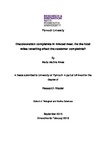Discolouration complaints in minced meat. Do the food miles travelling affect the customer complaints?
| dc.contributor.supervisor | Whitley, Liz | |
| dc.contributor.author | Martins Alves, Marta | |
| dc.contributor.other | School of Biological and Marine Sciences | en_US |
| dc.date.accessioned | 2018-03-16T13:17:19Z | |
| dc.date.available | 2018-03-16T13:17:19Z | |
| dc.date.issued | 2018 | |
| dc.identifier | 10358295 | en_US |
| dc.identifier.uri | http://hdl.handle.net/10026.1/11102 | |
| dc.description.abstract |
Meat discolouration is an area of significance to the meat processing industry since customers expect meat to have a bright red colour when purchased. Normally, when exposed to oxygen the myoglobin pigment in meat will give it this bright red colour as it is in the form of oxymyoglobin, but this may turn to the brown pigment metmyoglobin, and to prevent this meat is packed under a modified atmosphere containing a mix of carbon dioxide, oxygen and nitrogen. The factory under consideration, Factory X, is located in the far SW of the UK and dispatches meat to depots across the UK. During the summer of 2013, a large volume of complaints of meat discolouration in fresh, minced beef was received and it was thought that this might be linked to distance travelled. Results showed that this was not the case as complaints were not higher in depots at the greatest distance from the factory, nor were the complaints linked to specific depots. The study also showed that discolouration was not related to the modified atmosphere packaging process nor was shelf life insufficient. The study examined other factors that could influence meat discolouration and found that temperatures of product may exceed 8℃ on supermarkets’ shelves and thus temperature abuse could be a significant factor. During shopping trips customers may have a time lag between the purchase of meat products and refrigerating them once home and the study concluded that this may be one of the main reasons for discolouration. A factor of great importance to the meat industry that became apparent was the lack of adequate information about complaints from consumers to retailers and thence to the processor. This meant that it was not possible to perform complaint analysis and this then meant that a single cause could not be defined. It is recommended that a simple system be developed with the retailers for recording complaint details so that complete analysis can be performed. | en_US |
| dc.language.iso | en | |
| dc.publisher | University of Plymouth | |
| dc.rights | CC0 1.0 Universal | * |
| dc.rights.uri | http://creativecommons.org/publicdomain/zero/1.0/ | * |
| dc.subject | Discoloration | en_US |
| dc.subject | MAP | en_US |
| dc.subject | Mince meat | en_US |
| dc.subject | Shelf-life | en_US |
| dc.subject.classification | ResM | en_US |
| dc.title | Discolouration complaints in minced meat. Do the food miles travelling affect the customer complaints? | en_US |
| dc.type | Thesis | |
| plymouth.version | publishable | en_US |
| dc.identifier.doi | http://dx.doi.org/10.24382/917 | |
| dc.rights.embargoperiod | No embargo | en_US |
| dc.type.qualification | Masters | en_US |
| rioxxterms.funder | European Social Fund | en_US |
| rioxxterms.identifier.project | ESF Convergence | en_US |
| rioxxterms.version | NA |
Files in this item
This item appears in the following Collection(s)
-
01 Research Theses Main Collection
Research Theses Main



